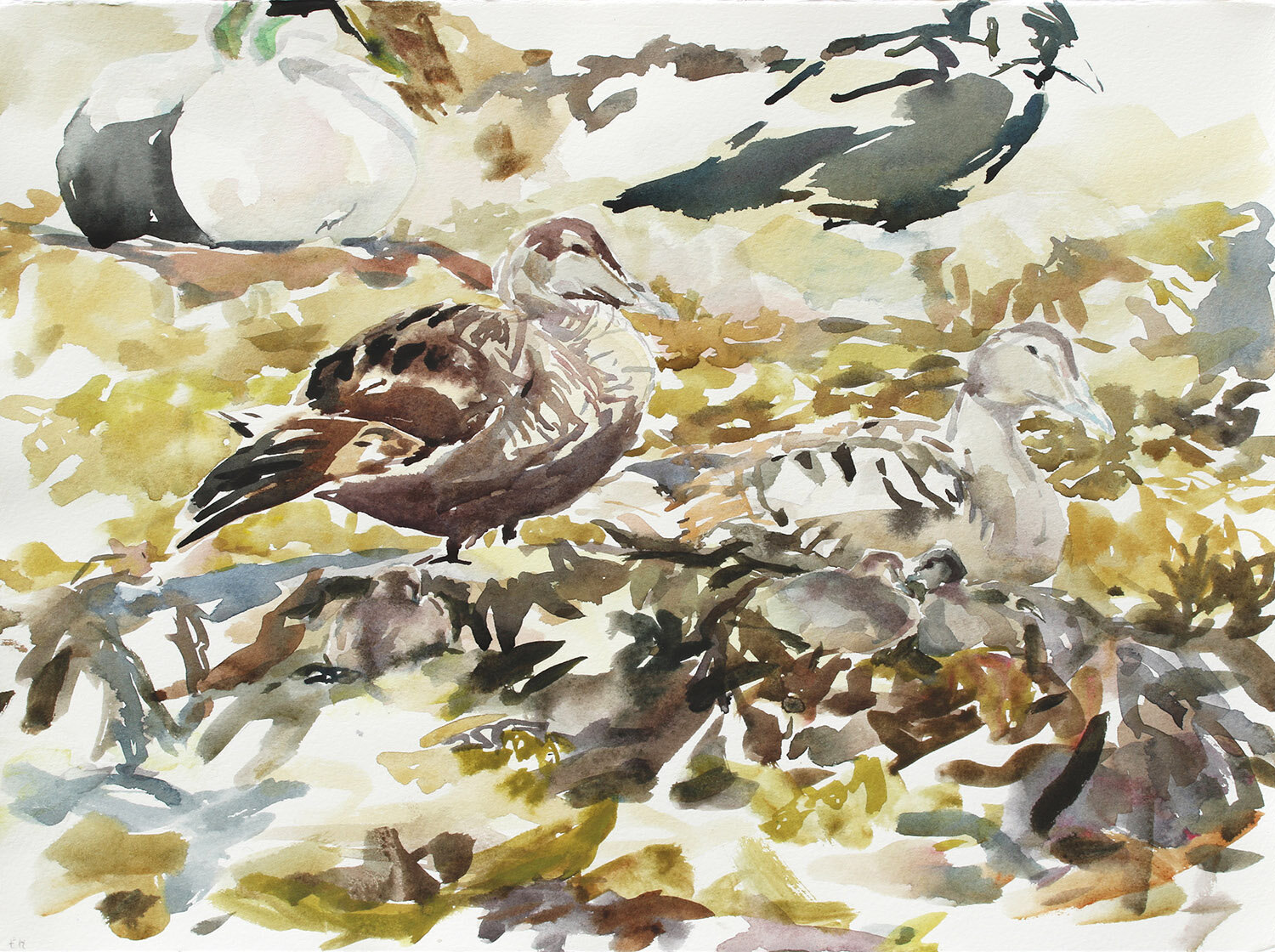Eider Crèche
5 May
Eider, Chicks and Carrion Crow; 5 May 2021, watercolour, 29 x 40cm
5 July, East Lothian: I walk approximately 2km along the beaches and slippery escarpments to find a broad cove without much disturbance. There are eiders close along the shoreline, mainly females grouped together with dozens of busy chicks. A few males in the distance are apart from this main group and far less active, white plumage glowing in the background. It’s hot in the unshaded sun, but luckily the spot I’ve found is in the trees, a few metres above the bay giving cover from rays and eyes. As the tide fell, Eider began to haul out on tips of submerged rocks to stretch and preen. They pause and pose a few minutes at a time before slipping away into the water again; just enough of an opportunity to capture a form with a fast brush stroke or two.
As the tide retreated further the rocky outposts became two great slabs of stratified rock running at right angles to the shore and a long way out into the sea. A calm inlet forms between the two slabs of rock, where the eider like to lead their crèche of chicks to feed in the silty shallows. More and more shelves of rock carpeted in thick glistening seaweed emerge as the inlet drys up. The eider seem to welcome this freshly drained land like an old friend. As one they clamber up its banks and nestle into matts of padded bladder wrack. Chicks bubble up everywhere, tumbling through the seaweed to keep up with the adults and before settling down to rest, they clamber on top of each other to form pyramids of 5, 6…10 or more downy individuals.
The ducks rest like this for a few minutes, sometimes half an hour at a time, before returning to feed and moving further out along the rocks always staying close to the retreating tide line. The whole event unfolds like a story and I paint it this way: A preening duck is joined by a resting duck, a perch just above the sea becomes an entire shoreline that eventually fills my page as the sea reveals more and more matted golden seaweed marks. Swaddled in the twists of wrack and kelp, tiny chicks appear. A carrion crow prowls too close, suddenly all alert, awake, gone.
6 May
Eider and Chicks; 6 May 2021, watercolour, 29 x 40cm
6 May, Slab Inlet, dropping tide: I return to the slabs today a couple of hours after high tide - I think the water level will be right for the eider and their chicks to haul onto the rocks where I have the best chance of a long view. This timing pays off and the ducks spend almost 30 minutes on a near ledge of rock. I focus on one duck with it’s head tucked under, a simple posture to study the intricate mottled barring and marbling of the female’s plumage. Wanting to capture the pose fast, I look to use the paint in ways that suggest the different textures for me. Then I look for different contrasting marks in the slippery seaweed and light airy down of the chicks. This way I build into a rhythm of mark making that feels new. The patterns and the brilliant colours of the seaweed is what keeps my interest in this subject and I pile heaps of yellow into an earthy palette. The ducks and chicks camouflage floats in and out of this golden landscape, appearing and drifting out of vision. It’s a strange dreamy image, ducks floating in gold and crimson seaweed with chicks tumbling around them. It keeps me returning all summer - exploring marks, colour and compositions.
3 June
3 June: Rain today, and a single duck study kept dry amongst wet and pooling seaweed strokes.
8 June
8 June, eider ducks treading mud in the shallows to release prey items for their chicks to feed on.
8 June, Slab Inlet: I arrive and the tides already very low. I hear the soft busy chattering sound Eider females make when corralling chicks before reaching the ledge and seeing, along the shore line, about 6 ducks protecting a crèche of over 50 chicks. The crèche busily upend and dive around the adults as they feed. The ducks I’ve noticed, as well as upending keep pushing them selves up in the water in a rocking motion. I realised today they are treading with their feet back and forth and this attracts the chicks to feed around them. They must be treading the mud in the shallows to stir up prey for the chicks. After the tide receded in the inlet I walked out to where the ducks had been feeding in the shallows and found hundreds of pock marks everywhere in the silty sand. They are shallow indents that look caused by a kind of suction pressure and I thought with so many of them it must be made by currents or perhaps worms at first, but thinking back to how vigorously the eider had been treading over this area just a few moments ago, I realise that they must be the cause of the small craters left in the mud.
17 July
Eider, 17 July; 40 x 58 cm, Watercolour.
Eider Crèche paintings starting to take own their own composition. Experimenting in the studio with arrangements of ducks in seaweed, making textures in watercolour and using palette to express different atmospheres. In this painting I was thinking about the ducks and chicks sleeping and playing with ideas of drifting and tried the yellow and blue palette after looking at Van Gogh’s swirling sky in Starry Night.
Observations
Resting Eider Study, Tyninghame
High Tide, still and dusk light on 14 June
Sketch book drawings form 3 July
Drake Eider at Tyninghame, momentary pause on rocks exposed on turning tide.









